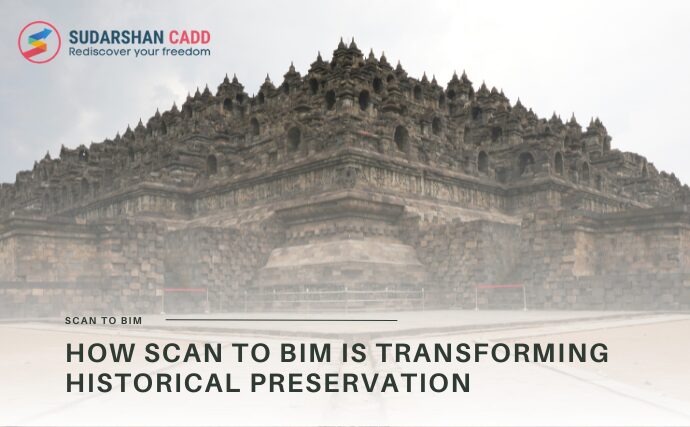
How Scan to BIM is Transforming Historical Preservation
Preserving historical structures is a meticulous and delicate process that requires a deep understanding of both architectural integrity and modern technology. Traditional methods of documentation and restoration are time-consuming, prone to human error, and often lack the level of detail necessary for accurate reconstruction. Enter Scan to BIM, a revolutionary technology that is reshaping historical preservation by providing highly detailed and precise digital models of heritage structures. In this blog, we explore how Scan to BIM is transforming historical preservation, its benefits, and how SCADD plays a pivotal role in this advancement.
What is Scan to BIM?
Scan to BIM is a process that involves using 3D laser scanning or photogrammetry to capture the existing conditions of a structure and convert them into a detailed Building Information Modeling (BIM) representation. This digital twin serves as a highly accurate model that can be used for analysis, restoration, and future planning of historical buildings.
The Role of Scan to BIM in Historical Preservation
1. Accurate Documentation of Heritage Structures
Traditional methods of documentation rely heavily on manual measurements, sketches, and 2D drawings. Scan to BIM automates this process by capturing millions of data points through laser scanning, ensuring a highly accurate digital representation of the structure. This allows preservationists and architects to work with reliable data, minimizing errors and discrepancies.
2. Digital Archiving for Future Generations
Many historical buildings face risks such as environmental damage, aging, and urban development pressures. By creating a precise digital archive using Scan to BIM, historians and conservationists can preserve the legacy of these structures, ensuring future restoration and educational opportunities.
3. Improved Restoration and Renovation Planning
Restoration efforts require a deep understanding of a building’s current condition. Scan to BIM enables conservationists to analyze structural elements, detect damages, and assess deterioration accurately. The BIM model serves as a valuable tool for planning restoration activities with precision and efficiency.
4. Enhanced Structural Analysis and Risk Assessment
With historical buildings often suffering from structural vulnerabilities, Scan to BIM provides engineers with the necessary data to analyze stability, material degradation, and potential failure points. This helps in designing appropriate reinforcement and preservation strategies while maintaining architectural authenticity.
5. Efficient Project Collaboration and Stakeholder Communication
BIM models allow seamless collaboration among architects, engineers, historians, and government agencies involved in preservation projects. The ability to visualize, annotate, and share detailed 3D models ensures everyone involved has a comprehensive understanding of the building’s condition and the restoration plans.
Top Benefits of Using Scan to BIM in Historical Preservation
- Time Efficiency: Reduces the time needed for surveying and documentation compared to traditional methods.
- Cost Savings: Minimizes rework and enhances accuracy, reducing costly errors in restoration projects.
- Preservation of Architectural Integrity: Ensures that historical details and unique features are meticulously captured and maintained.
- Data-Driven Decision Making: Enables restoration teams to make informed decisions based on precise digital data.
How SCADD Helps You with Scan to BIM for Historical Preservation
SCADD specializes in providing high-quality Scan to BIM services tailored to historical preservation needs. Our expertise ensures that heritage structures are documented and analyzed with the highest precision. Our services include:
- High-Resolution 3D Laser Scanning: Capturing intricate details of historical buildings with industry-leading accuracy.
- BIM Model Creation: Converting scanned data into intelligent BIM models for comprehensive analysis.
- Structural Assessment & Analysis: Identifying potential weaknesses and planning reinforcements while preserving original aesthetics.
- Restoration Planning & Consultation: Assisting stakeholders in developing effective restoration strategies with minimal disruptions.
Conclusion
Scan to BIM is revolutionizing historical preservation by offering unparalleled accuracy, efficiency, and collaboration in documenting and restoring heritage structures. By integrating advanced scanning technology with BIM, we can ensure the longevity and authenticity of our architectural heritage. SCADD’s expertise in Scan to BIM enables clients to navigate the complexities of historical preservation with confidence, ensuring that these treasures are preserved for generations to come.
Ready to Transform Your Historical Preservation Projects with Scan to BIM? Get in touch with SCADD today and leverage the power of BIM for preserving the past while embracing the future!
FAQs
- How does Scan to BIM differ from traditional preservation methods?
Scan to BIM automates and digitizes the documentation process, offering more precision and efficiency compared to manual measurements and 2D drawings. - What types of historical buildings can benefit from Scan to BIM?
From ancient monuments and churches to colonial-era buildings and palaces, any historical structure can benefit from Scan to BIM for restoration and documentation. - How long does it take to scan and create a BIM model for a historical site?
The timeframe depends on the size and complexity of the building, but typically, scanning can be completed in a few days, with BIM modeling taking a few weeks. - Can Scan to BIM help with structural integrity assessment?
Yes, the BIM model provides engineers with crucial data for analyzing structural stability and planning reinforcements while preserving original designs. - How does Scan to BIM contribute to sustainable preservation?
By reducing physical interventions and optimizing restoration strategies, Scan to BIM supports sustainable conservation efforts and minimizes resource wastage.

